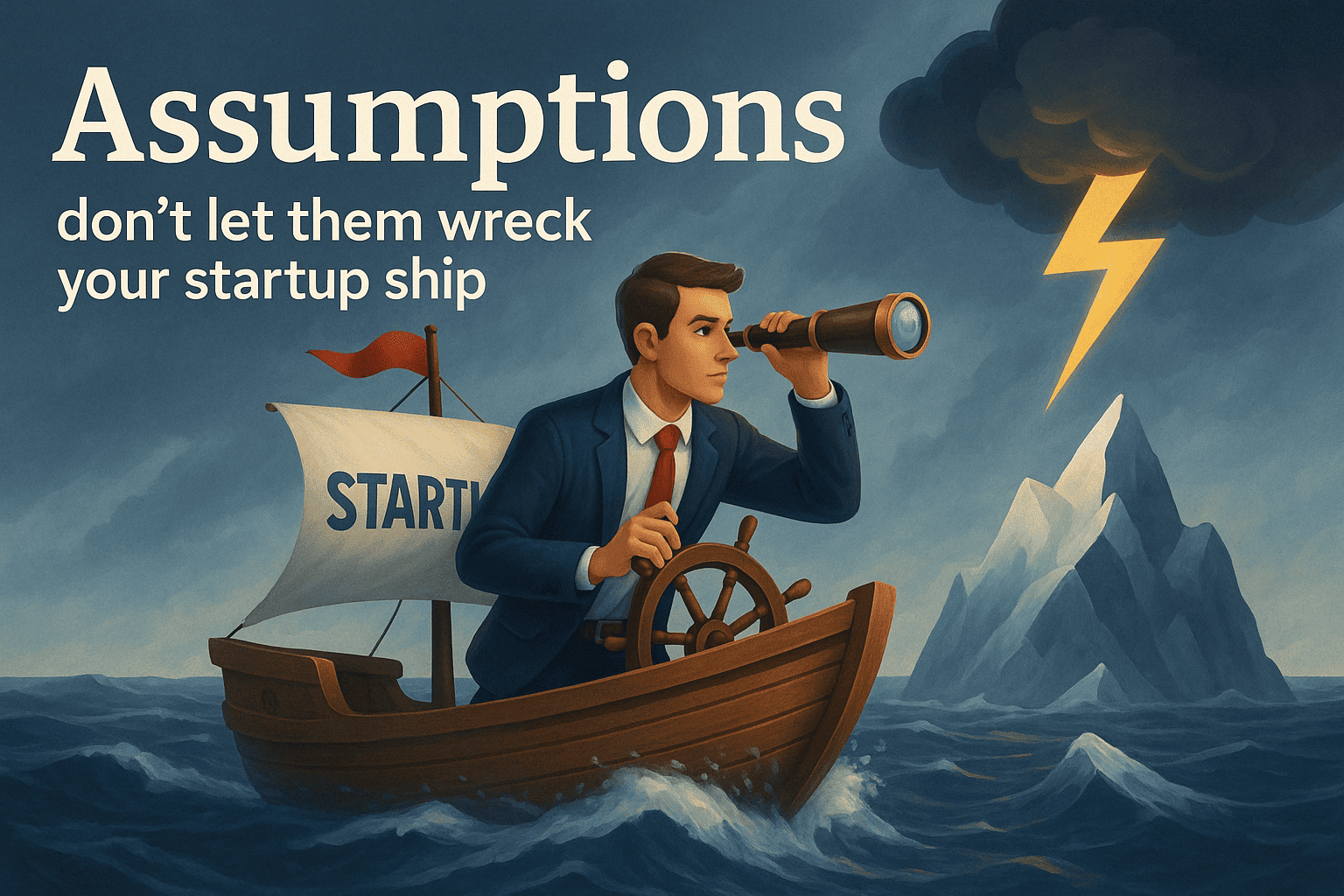
02 May Assumptions: don’t let them wreck your startup ship
Banner image generated using ChatGPT, OpenAI, (01.05.2025)
Startups, by nature, operate in environments of high uncertainty. One of the integral aspects in a startup’s journey is the assumptions founders make, which they are often not aware. Decisions are always based on some assumptions even when based on data & research. To navigate this, founders must systematically identify the assumptions on which their business is predicated.
We discuss this aspect with our cohort founders in multiple ways. However, we realize that as incubators we need to pay more attention to the assumptions and the underlying beliefs startup founding teams have early in their journey when making business decisions.
These assumptions, which make or break startups, are often untested and shape decisions about customers, products, markets, and financials. Startups can uncover and clarify critical assumptions and take steps by being deliberate and systematic in their approach:
1) Use Frameworks to Map Out Assumptions
Tools like the Lean Canvas, Business Model Canvas, customer journey mapping help to visually map a startup’s business model and could help surface the underlying assumptions they might have made. These frameworks prompt founders to articulate their beliefs about customer segments, value propositions, revenue streams, cost structures, and more. By filling out each section, startup teams (yes, best done as a team) can learn about the assumptions embedded in their business plan.
2) Categorize Assumptions by Type
Assumptions typically fall into several categories[1]:
- Desirability: Is there a real problem we are tackling? Is there a market for the idea? Do customers actually want this product or feature?
Common assumptions: If we build it, they will come/buy. Customers will know how to use the product. The product is the most important thing – we have a product/solution that will really work.
- Feasibility: Can we build and deliver this solution with our current resources and technology? Can we deliver at scale?
Common assumptions: No one has really built it or built it this way. Early traction means long term success. Early traction means we just need to replicate what and how we do things now when expanding.
- Viability: Is the idea profitable? Can the business make money from this?
Common assumptions: Growth is the most important thing; we can figure out monetization/profitability later. Only if we raise funding are we successful.
- Adaptability: Can the idea survive in a changing market environment? Can the product or business adapt to market or environmental changes?
- Common assumptions: We can do it no matter what (think team, capabilities, expertise, networks, etc.). We know what we are doing.
There could be many more assumptions, which can be listed and categorised. E.g., Usability: Will users be able to use the product as intended? But the general idea is to categorize assumptions for ease of discussing with the team.
3) Identify the “Business Critical Assumptions”
Not all the assumptions that startups make are equally critical. Focus on those that, if proven false, would fundamentally undermine the business.
A few common high-impact assumptions include:
- Customer need exists and the problem is real and present, for which customer will be willing to pay the price we are asking.
- Early adopters indicate the need for the product/solution is there and will lead to broader adoption and hence growth
- Funding will be available when needed
4) Turn Assumptions into Testable Hypotheses
Rather than vague beliefs, assumptions should be written as clear, testable statements (hypotheses). For instance, instead of “People will bring empty plastic bottles to refill homecare products at our kiosk,” reframe as “If a refill kiosk for homecare products is made available, then at least 30% of customers will bring their own empty plastic bottles to use it within the first month of operation.” This clarity makes it easier to prioritize and test. Also, there should be some basis for coming up with the 30% figure. And yes, RBuy Solutions, one of our startups is deploying automated refilling kiosks and enabling customers to conveniently refill their laundry and home care products in reusable containers.
5) Validate with Research and Experimentation
Once identified, assumptions should be validated through:
- Customer interviews and surveys to test desirability and willingness to pay
- Prototypes, MVPs, or landing pages to test product-market fit and usability
- Technical feasibility assessments with the development team
- Market analysis and competitive research to test viability
That is the broad process startups can follow to test their assumptions and reduce the risk of failure. Startups need to be able to identify the riskiest assumptions as soon as possible, test them and take steps to address/remedy – e.g. modify product, pivot business model, change GTM strategy, etc. and then iterate this process so that it becomes a habit. Also, leverage key stakeholders – team, mentors, investors and of course incubators you are part of.
Ravi Sarkunan leads IIITH’s Social Incubator and has been working closely with social impact startups (both tech-based and otherwise) for the past 10+ years.
Footnotes:
[1] https://www.strategyzer.com/library/how-assumptions-mapping-can-focus-your-teams-on-running-experiments-that-matter


